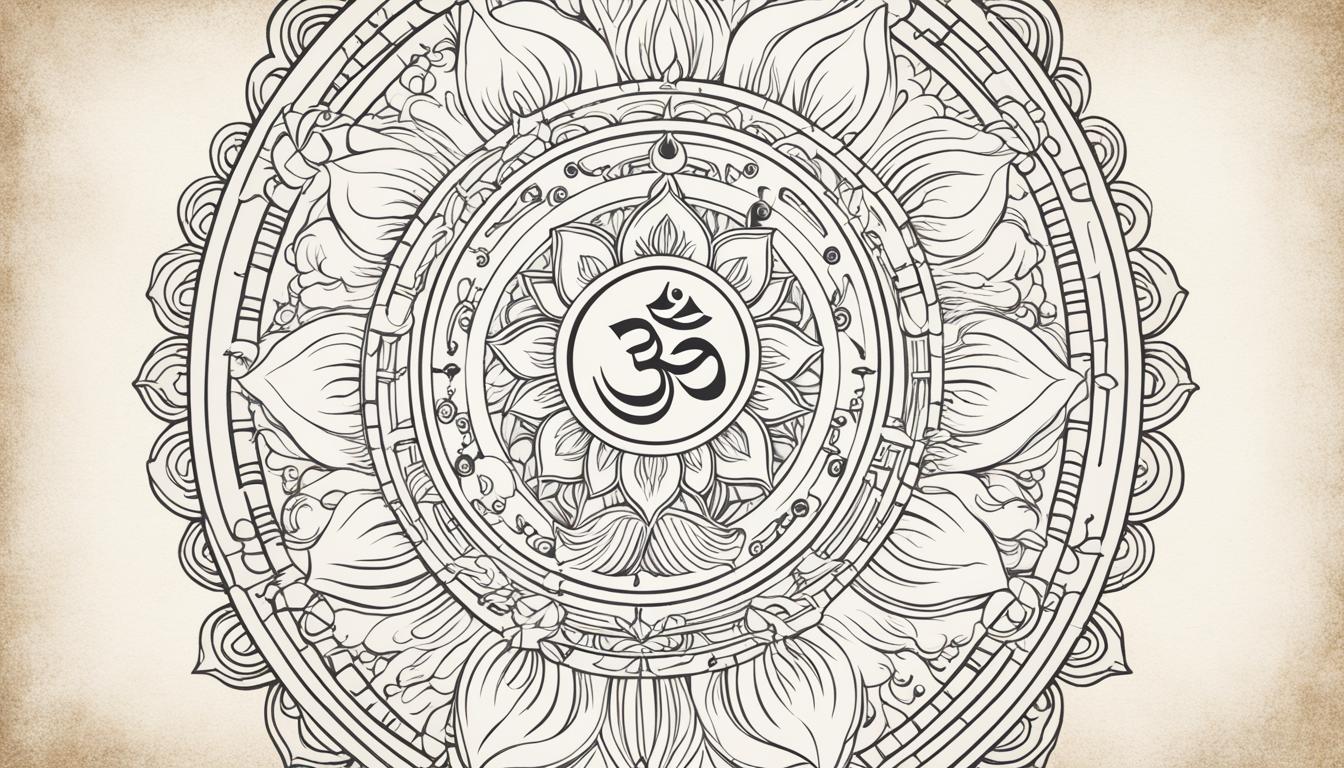Have you ever wondered about the profound meaning behind the captivating symbols of Buddhism? These symbols not only embellish temples and artworks but also hold deep spiritual significance in the practice and understanding of this enlightening religion. Journey with us as we explore the symbolism of Buddhism, unraveling the essence of peace and enlightenment that these symbols embody.
Key Takeaways:
- Discover the deep spiritual significance behind Buddhism symbols.
- Explore how Buddhism symbols represent peace and enlightenment.
- Understand the role of symbols in meditation and mindfulness practices.
- Unveil the cultural and artistic influences of Buddhism symbols.
- Gain insight into the relevance of these symbols in modern society.
The Reclining Buddha: The Symbol of Transition
Immerse yourself in the profound symbolism of the Reclining Buddha, a revered icon in Buddhism. Also known as the Parinirvana Buddha, this symbol represents the Buddha’s final moments on Earth, depicting his transition towards Parinirvana – the ultimate state of enlightenment, liberation, and eternal peace.
The Reclining Buddha embodies the profound teachings of impermanence and the transient nature of life. It serves as a poignant reminder that all things in life, including our physical existence, are subject to change. This reclining pose portrays the Buddha lying on his right side, resting peacefully, signifying the tranquility and serenity attained through enlightenment.
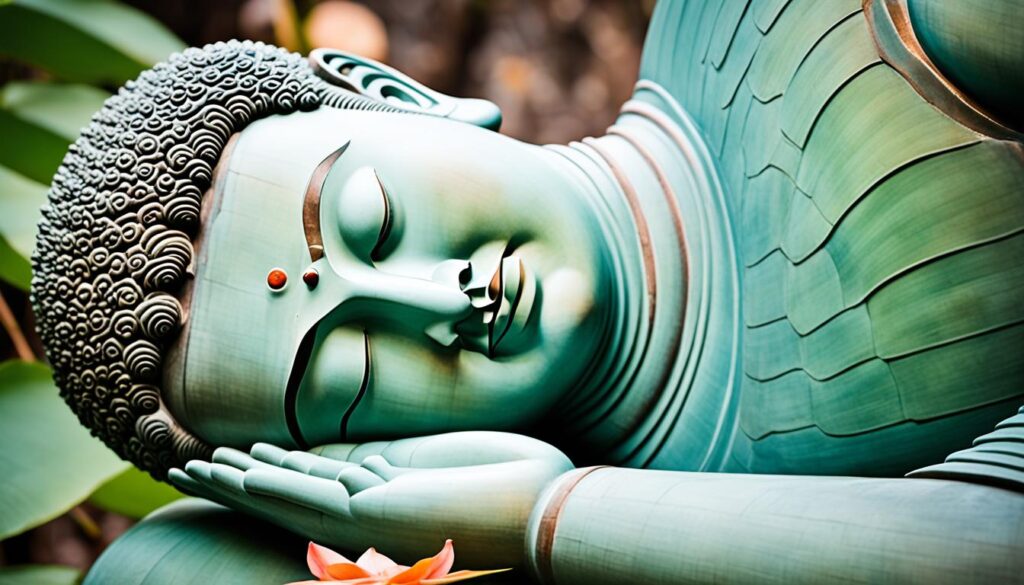
The sublime image of the Reclining Buddha resonates with practitioners, guiding them to embrace impermanence and find solace within the journey of life’s transitions. It symbolizes the Buddha’s ultimate triumph over suffering, attaining liberation from the cycle of birth and death.
As you delve deeper into the Reclining Buddha’s meaning, contemplate the impermanence of existence and embrace the transformative power of spiritual enlightenment. Embody the tranquility and peace that this sacred symbol represents, inspiring your own journey towards self-discovery and inner serenity.
Nirvana Buddha: The Embodiment of Enlightenment
The Nirvana Buddha symbolizes the moment when the Buddha achieved complete enlightenment and liberation from the cycle of suffering. It serves as a powerful reminder of the transformative journey towards spiritual awakening and inner peace.
At the core of Buddhism lies the pursuit of nirvana, a state of liberation from the endless cycle of birth, death, and rebirth. The Nirvana Buddha, also known as the Mahaparinirvana Buddha, encapsulates the essence of this transcendence.
When you gaze upon the image of the Nirvana Buddha, you are greeted by serene countenance and a reclining posture. This representation signifies the Buddha’s final moments in his earthly existence, as he prepared to enter the state of final enlightenment, known as Parinirvana. It is believed that the Buddha attained nirvana at the age of 80, leaving behind his mortal body and reaching the state of ultimate bliss.
The Nirvana Buddha symbolizes the complete extinguishing of desires, attachments, and suffering. It embodies the attainment of wisdom, compassion, and inner harmony, inspiring countless followers to embark on their own spiritual journey towards enlightenment.
The image of the Nirvana Buddha is a constant visual reminder for Buddhists to strive for liberation from the cycle of suffering. It represents the possibility of transcending worldly challenges and embracing a life of peace, compassion, and self-realization.
The Symbolism of the Nirvana Buddha
The Nirvana Buddha symbolizes several profound concepts and teachings within Buddhism:
- Enlightenment: The Nirvana Buddha represents the ultimate state of awakening and profound spiritual realization, free from ignorance and suffering.
- Transcendence: The image of the reclining Buddha signifies the transition from the physical realm to the realm of enlightenment, marking the end of the cycle of birth, death, and rebirth.
- Inner Peace: The serene and peaceful expression of the Nirvana Buddha serves as a reminder to cultivate tranquility and serenity within, even amidst life’s challenges.
- Impermanence: The reclining posture of the Nirvana Buddha emphasizes the transient nature of existence and reinforces the understanding of impermanence as a fundamental aspect of life.
The Nirvana Buddha symbolizes the culmination of the Buddha’s spiritual journey and his selfless quest to alleviate suffering in the world. Its presence in Buddhist art and temples provides a constant source of inspiration and guidance for practitioners seeking liberation and enlightenment.

Honoring the Legacy of Buddha Through Art
The Reclining Buddha and Nirvana Buddha statues are extraordinary examples of the profound connection between Buddhism and art. These meticulously crafted sculptures serve as powerful embodiments of the teachings and legacy of Siddhartha Gautama, the revered figure behind Buddhism.
The Reclining Buddha statue, also known as the Parinirvana Buddha, captures the final moments of the Buddha’s life on Earth. It symbolizes his journey towards Parinirvana, the ultimate state of enlightenment and liberation from the cycle of birth and death. This awe-inspiring statue invites reflection on the transient nature of existence and the transformative power of spiritual awakening.
The Nirvana Buddha statue portrays the Buddha in a meditative pose, representing the very moment he reached complete enlightenment and attained eternal peace. Through its serene depiction, it serves as a constant reminder of the inner tranquility and harmony that can be achieved through the practice of Buddhism.
These Buddha statues, with their exquisite artistry and deep symbolism, have captivated the imaginations of both Buddhists and art enthusiasts alike. They not only honor the enduring legacy of the Buddha but also inspire contemplation of life’s complexities, the potential for personal transformation, and the pursuit of inner serenity.
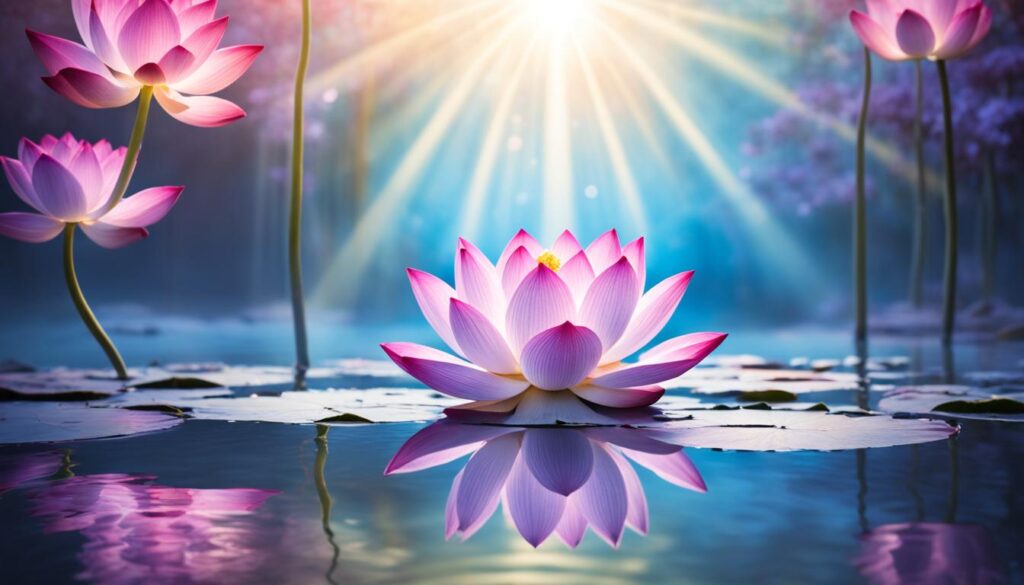
The Artistry and Symbolism of the Buddha Statues
The Reclining Buddha and Nirvana Buddha statues are not just artistic masterpieces, but they also convey profound spiritual messages. Each intricate detail in these sculptures holds significance and contributes to the overall symbolism.
The Reclining Buddha, usually depicted lying on his right side with his head resting on his right hand, symbolizes tranquility, detachment, and the impermanence of life. It reminds us of the transient nature of all things and encourages us to embrace change and let go of attachments.
The Nirvana Buddha, often seen meditating with crossed legs and a serene expression, represents enlightenment, compassion, and the liberation from suffering. It symbolizes the ultimate goal of the Buddhist path – transcending worldly desires and achieving inner peace.
As individuals observe and engage with these statues, they are invited to contemplate the teachings of the Buddha and embark on their own spiritual quest towards enlightenment. The combination of artistic craftsmanship and profound symbolism makes these Buddha statues not only aesthetically stunning but also deeply meaningful.
The Origin and Significance of Buddha Symbols
Buddhism symbols hold deep spiritual meanings and play a significant role in the practice and understanding of the religion. They are designed to convey important concepts and teachings, such as impermanence, enlightenment, compassion, and inner peace.
The symbolism in Buddhism is rooted in the life and teachings of Siddhartha Gautama, the historical Buddha. These symbols have evolved over time and differ across various Buddhist traditions and cultures.
Let’s explore some of the most widely recognized Buddhism symbols and their significance:
The Lotus Flower: Symbol of Purity and Enlightenment
The lotus flower is a revered symbol in Buddhism, representing purity and spiritual awakening. Just as the lotus rises above muddy waters to blossom, it symbolizes the journey from ignorance to enlightenment. The unfolding petals of the lotus represent the gradual development of one’s spiritual potential.
The Dharma Wheel: Symbol of the Noble Eightfold Path
The dharma wheel, or dharmachakra, is a fundamental symbol in Buddhism. It represents the Noble Eightfold Path, which encompasses the ethical conduct, mental discipline, and wisdom teachings of Buddhism. The wheel’s turning motion symbolizes the continuous cycle of birth, death, and rebirth.
The Bodhi Tree: Symbol of Awakening
The Bodhi tree is the tree under which the Buddha attained enlightenment. It serves as a symbol of awakening and spiritual realization. Sitting under a bodhi tree, deep in meditation, the Buddha discovered profound insights into the nature of existence and the means to transcend suffering.
The Om Mani Padme Hum: Mantra and Symbol
The mantra “Om Mani Padme Hum” is one of the most widely recited and revered mantras in Buddhism. It encapsulates the compassionate essence of the bodhisattva Avalokiteshvara, representing the path of altruism and liberation. The six syllables of the mantra symbolize the purification of the six realms of existence.
These are just a few examples of the rich symbolism found in Buddhism. Each symbol holds its own significance and serves as a reminder of the profound spiritual teachings that guide Buddhists on their path to enlightenment.
Buddhism Symbols and Their Meanings:
| Symbol | Meaning |
|---|---|
| Lotus Flower | Represents purity and spiritual awakening. |
| Dharma Wheel | Symbolizes the Noble Eightfold Path and the Buddha’s teachings. |
| Bodhi Tree | Serves as a symbol of awakening and spiritual realization. |
| Om Mani Padme Hum | Represents compassion, altruism, and liberation. |
The beauty and profundity of Buddhism symbols extend far beyond what can be expressed in words alone. They inspire and guide practitioners in their pursuit of inner peace, enlightenment, and compassion.

The Role of Buddha Symbols in Meditation and Mindfulness
In the practice of Buddhism, meditation and mindfulness are fundamental techniques for cultivating inner peace, clarity, and spiritual growth. Buddha symbols play a crucial role in these practices, serving as visual focal points that aid in concentration and evoke specific qualities and states of mind.
During meditation, focusing on a particular symbol can help calm the mind, quiet external distractions, and deepen one’s awareness of the present moment. Whether it’s a Buddha statue, a lotus flower, or a sacred mantra, these symbols act as anchors, guiding practitioners into a state of stillness and tranquility.
In mindfulness practices, Buddha symbols serve as reminders of the teachings and principles of Buddhism. They help individuals stay present, attentive, and non-judgmental, cultivating a deep connection with the present moment and the wisdom of Buddha.
The Power of Buddhism Meditation Symbols
Buddhism meditation symbols hold profound meaning and can evoke specific qualities and states of mind. Here are a few examples:
- The lotus flower: Symbolizing purity and enlightenment, the lotus reminds practitioners to rise above worldly attachments and strive for spiritual awakening.
- The Bodhi tree: Representing the tree of awakening under which the Buddha attained enlightenment, the Bodhi tree symbol inspires seekers to realize their own inner awakening.
- The dharma wheel: Signifying the Noble Eightfold Path, the dharma wheel symbol encourages individuals to follow the path of ethical conduct, mindfulness, and wisdom.
The use of Buddha symbols during meditation and mindfulness practices expands beyond the visual realm. Sound, touch, and smell can also be incorporated into the practice. Mantras, prayer beads, incense, and essential oils are examples of how these senses can complement the visual symbolism, enhancing the overall experience of meditation and mindfulness.

Exploring the Symbolic Meanings of Buddha Symbols in Practice
To better understand the symbolic meanings of Buddha symbols in meditation and mindfulness, let’s explore a selection of common symbols in practice:
| Symbol | Meaning |
|---|---|
| Lotus flower | Represents the purity of body, speech, and mind |
| Dharma wheel | Signifies the cycle of life, death, and rebirth |
| Bodhi tree | Symbolizes the Buddha’s enlightenment and spiritual awakening |
| Mandala | Represents the universe and the interconnectedness of all beings |
| Infinite knot | Symbolizes the interconnectedness of all phenomena and the eternal nature of the Buddha’s teachings |
These symbols, when utilized during meditation and mindfulness practices, help practitioners align their intentions and immerse themselves in the wisdom and teachings of Buddhism. Each symbol carries its own unique energy and significance, resonating with different people in various ways.
By incorporating Buddha symbols into your meditation and mindfulness practices, you invite a deeper connection with the essence of Buddhism. They serve as powerful reminders of the path to enlightenment, compassion, and inner peace.
Buddhism Symbol Meanings and Interpretations
Each Buddhism symbol carries its own unique meaning and interpretation. These symbols are not mere decorations; they hold deep spiritual significance and offer profound insights into the teachings and philosophy of Buddhism. By understanding the significance of these symbols, you can enhance your understanding of Buddhist teachings and apply their wisdom to your own spiritual journey.
The Lotus Flower: Purity and Enlightenment
The lotus flower is a revered symbol in Buddhism, representing purity, spiritual growth, and enlightenment. Just as a lotus rises from muddy waters to blossom and reach for the sun, Buddhists strive to rise above the suffering and attachments of the world to achieve inner liberation and enlightenment.
The Dharma Wheel: The Noble Eightfold Path
The dharma wheel, also known as the dharmachakra, is a powerful symbol that represents the Noble Eightfold Path—the path to liberation from suffering. It consists of eight interconnected principles, including right understanding, right intention, right speech, right conduct, right livelihood, right effort, right mindfulness, and right concentration. The dharma wheel reminds practitioners to follow these principles and cultivate a balanced and righteous way of life.
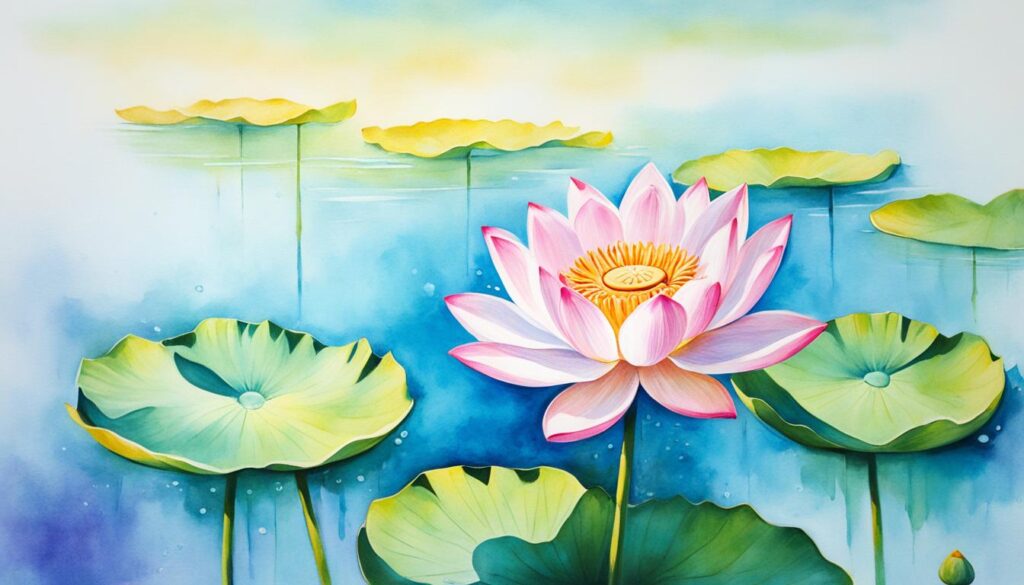
The Bodhi Tree: Awakening and Enlightenment
The bodhi tree holds great significance in Buddhism as it is believed to be the tree under which Siddhartha Gautama attained enlightenment and became the Buddha. It symbolizes awakening, spiritual growth, and the realization of one’s true nature. Buddhists revere the bodhi tree as a reminder of the potential for enlightenment within every individual.
The Infinite Knot: Interconnectedness
The infinite knot, also known as the endless knot, is a symbol of the interconnectedness of all things in the universe. It represents the cyclical nature of existence, where everything is interconnected and interdependent. It serves as a reminder to cultivate compassion, wisdom, and mindfulness in our interactions with others and the world around us.
Understanding the meanings and interpretations of Buddhism symbols allows you to delve deeper into the teachings and philosophy of Buddhism. These symbols serve as visual reminders of important spiritual concepts, guiding you on your path to inner peace, enlightenment, and awakening.
The Cultural Significance of Buddhism Symbols
Buddhism symbols hold immense cultural significance in the regions where Buddhism is practiced. These symbols are intricately woven into the fabric of art, architecture, and everyday life, becoming iconic representations of the religion and its teachings in diverse cultures.
The incorporation of Buddhism symbols in cultural practices serves to reaffirm and celebrate the spiritual values they represent. Whether it is through vibrant festivals, religious rituals, or the adornment of sacred spaces, these symbols breathe life into the rich tapestry of Buddhist traditions.
The profound influence of Buddhism symbols in culture is experienced firsthand when one immerses themselves in the cultural spaces where these symbols are revered. They often inspire awe, reverence, and a sense of connection to something greater than oneself.
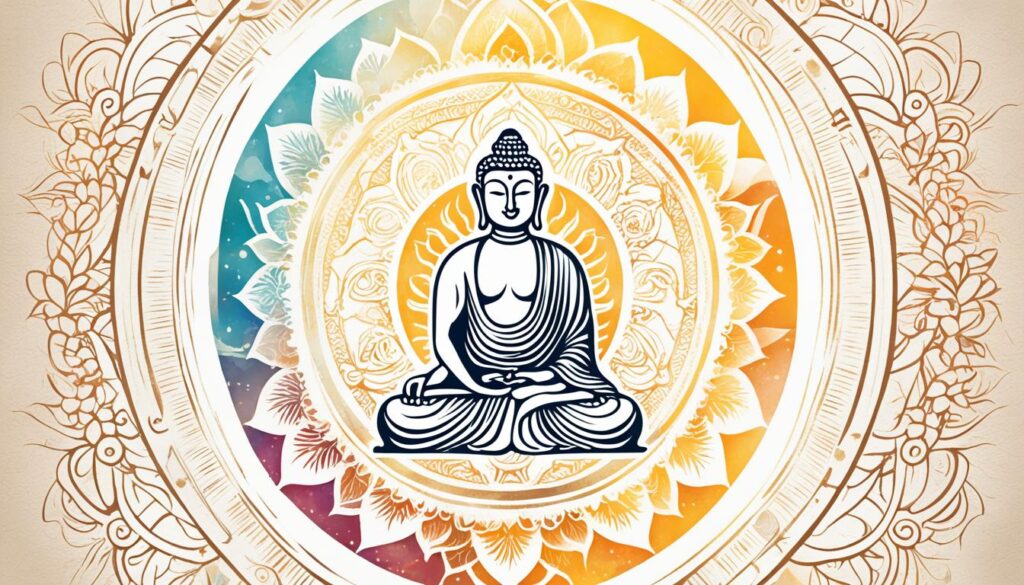
The Cultural Integration of Buddhism Symbols
The cultural integration of Buddhism symbols is evident in various aspects of society, such as:
- Art and Sculpture: Buddhist symbols are skillfully portrayed in sculptures, paintings, and murals, creating evocative masterpieces that depict the spiritual depth of the religion.
- Architecture: Buddhist temples, stupas, and monasteries feature intricate designs and embellishments that incorporate symbols and motifs, symbolizing the transcendent nature of Buddhist teachings.
- Everyday Life: Buddhism symbols are often woven into daily rituals, ceremonies, and practices. From prayer flags fluttering in the wind to intricately designed amulets worn for protection, these symbols serve as constant reminders of Buddhist principles.
- Textile and Fashion: Buddhism symbols find their way into textiles, clothing, and accessories, allowing individuals to express their devotion and alignment with the Buddhist philosophy.
The cultural significance of Buddhism symbols extends beyond aesthetic beauty. They serve as potent reminders of the transformative power of compassion, mindfulness, and wisdom in the lives of individuals and communities.
| Cultural Aspect | Example |
|---|---|
| Art and Sculpture | Statues of the Buddha, intricate mandalas |
| Architecture | Temples, stupas, pagodas |
| Everyday Life | Prayer flags, amulets, incense rituals |
| Textile and Fashion | Buddhist-inspired clothing, jewelry |
Exploring Buddhist Colors and Color Symbolism
Colors hold a significant role in Buddhism, serving as powerful symbols with deep spiritual meanings that enrich the practitioner’s spiritual journey. Each color represents different aspects of Buddhist teachings, evoking emotions, and fostering a connection with the divine. Understanding the color symbolism in Buddhism adds depth and nuance to your exploration of this peaceful and enlightening religion.
Gold: Symbolizing Enlightenment and Spirituality
Gold is a vibrant and radiant color in Buddhism that symbolizes enlightenment and spirituality. It represents the highest state of consciousness, reflecting the wisdom and compassion of the awakened mind. The shimmering gold of Buddha statues and religious artifacts illuminates the path towards spiritual awakening, inspiring practitioners to strive for inner transformation and the pursuit of truth.
Blue: The Calming Essence of Purity and Wisdom
Blue is an integral color in Buddhism, embodying the calming essence of purity and wisdom. It reflects the tranquil and serene nature of the enlightened mind, promoting feelings of peace and clarity. The deep blue hue is associated with the vastness of the sky and the boundless wisdom of the Buddha. It encourages practitioners to cultivate pure and compassionate thoughts, guiding them on the path towards liberation from suffering.
Red: The Symbol of Power and Transformation
Red holds a powerful symbolism in Buddhism, signifying both power and transformation. It represents the vitality of life, energy, and determination on the spiritual path. Red is often associated with wrathful deities, symbolizing the ability to transform negative emotions and passions into wisdom and compassion. It serves as a reminder to embrace change and cultivate inner strength to navigate the complexities of existence.
White: The Pure and Illuminating Light
White is a color of purity and illumination in Buddhism, representing the enlightened mind that transcends all duality. It embodies the absence of defilements and the clarity of wisdom, symbolizing the liberation from ignorance and the attainment of enlightenment. The white lotus, often depicted in Buddhist art, exemplifies the pristine nature of the awakened mind, inspiring practitioners to cultivate pure intentions and thoughts.

The use of colors in Buddhism serves as a visual language that communicates profound concepts and teachings. It invites practitioners to connect with their emotions, cultivate mindfulness, and deepen their understanding of the path to enlightenment. Embrace the symbolic power of colors on your spiritual journey and let them guide you towards inner peace and awakening.
The Wheel of Buddhism: Symbol of Dharma and Spiritual Path
In Buddhism, the dharma wheel, also known as the dharmachakra, holds profound symbolism and represents the Noble Eightfold Path as taught by the Buddha. This sacred wheel embodies the essential teachings and principles that guide practitioners on their spiritual journey toward liberation from suffering and attaining enlightenment.
Derived from ancient Indian traditions of chariot wheels, the dharma wheel is a powerful metaphor for the continuous cycle of birth, death, and rebirth. It symbolizes the interconnectedness of all beings and the impermanence of existence. Just as a wheel turns, life unfolds in a perpetual motion of change and transformation.
At the center of the wheel are three basic components that form the foundation of Buddhism: moral discipline (sila), mental cultivation (samadhi), and wisdom (prajna). These elements represent the three pillars of Buddhist practice and guide individuals toward living a virtuous life, cultivating mindfulness, and gaining insight into the true nature of reality.
The dharma wheel is often depicted with eight spokes, representing the Noble Eightfold Path, which encompasses the Buddha’s teachings on ethical conduct, mental discipline, and wisdom. The eight spokes symbolize the following aspects:
- Right View
- Right Intention
- Right Speech
- Right Action
- Right Livelihood
- Right Effort
- Right Mindfulness
- Right Concentration
These eightfold path spokes illustrate the way to lead a mindful and ethical life, cultivate wholesome qualities, and transcend the cycle of suffering. Each spoke represents a crucial aspect of personal and spiritual development, ultimately leading to the realization of enlightenment.
The dharma wheel is an enduring symbol in Buddhist art, architecture, and literature, serving as a constant reminder of the path to liberation and the wisdom contained within the Buddha’s teachings. It inspires practitioners to embark on their own spiritual journey, following the guidance of the wheel and the dharma it represents.

| Symbol | Representation |
|---|---|
| Wheel | The continuous cycle of birth, death, and rebirth |
| Eight Spokes | The Noble Eightfold Path |
| Moral Discipline (Sila) | Virtuous conduct and ethical living |
| Mental Cultivation (Samadhi) | Meditation and concentration practices |
| Wisdom (Prajna) | Insight into the true nature of reality |
Exploring Buddhism Symbols in Vajrayana Buddhism
Vajrayana Buddhism, also known as the Diamond Way or Thunderbolt Way, encompasses a rich collection of symbols and iconography that hold deep spiritual significance. These symbols serve as powerful tools for practitioners to navigate the path to enlightenment and transform negative emotions into wisdom and compassion.
One of the key symbols in Vajrayana Buddhism is the dorje, which represents the indestructible and immutable nature of reality. It is often depicted as a double-pronged thunderbolt or diamond scepter. The dorje symbolizes the indestructibility of the awakened mind and the power to overcome obstacles on the path to enlightenment.
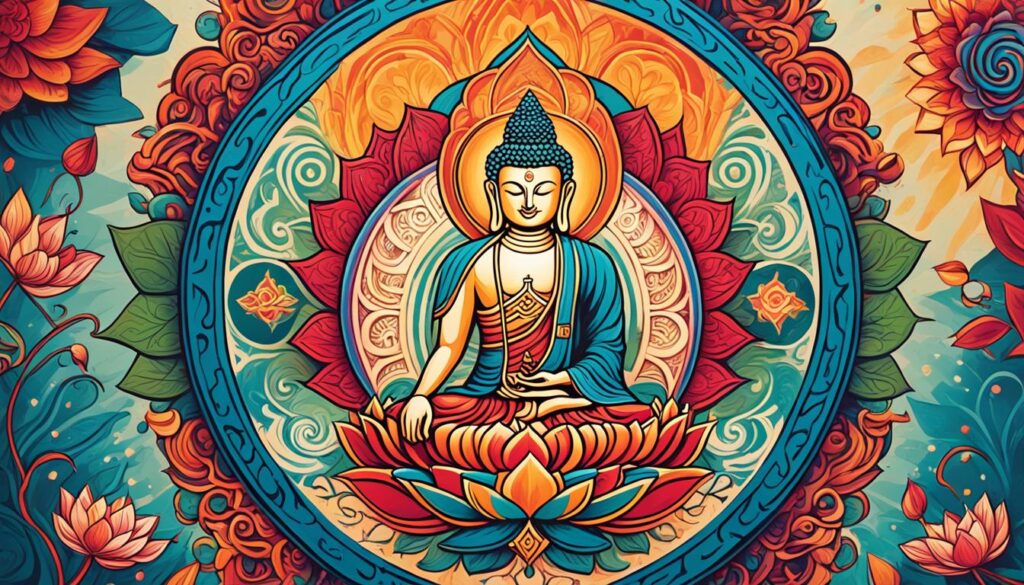
The bell is another essential symbol in Vajrayana Buddhism. It represents the feminine aspect of enlightenment, wisdom, and the void. The bell is often used in rituals and meditation practices to awaken clarity and mindfulness. Its sound is believed to purify the environment and guide practitioners towards spiritual awakening.
These symbols, along with many others, form a visual language that communicates profound teachings and concepts in Vajrayana Buddhism. They invite practitioners to delve into the depths of their own consciousness and uncover the innate wisdom and compassion that resides within.
Buddhism Symbols and Their Relevance in Modern Society
In today’s fast-paced and often chaotic world, the wisdom and guidance offered by Buddhism symbols continue to hold great relevance. These symbols serve as powerful reminders to embrace mindfulness, compassion, and peace in our daily lives, fostering harmony and well-being.
Embracing Mindfulness
The lotus flower, a prominent symbol in Buddhism, represents purity and enlightenment. Its blooming petals remind us to cultivate mindfulness and be fully present in the moment. By practicing mindfulness, we can heighten our awareness, reduce stress, and cultivate a deeper sense of peace.
Cultivating Compassion
The symbol of the Bodhisattva, a compassionate being who works for the benefit of all sentient beings, encourages us to cultivate compassion in our interactions with others. It reminds us to extend kindness, empathy, and understanding, creating a more compassionate and inclusive society.
Fostering Inner Peace
The image of a meditating Buddha, with a serene expression and crossed legs, symbolizes inner peace and tranquility. It serves as a reminder to seek inner calm amidst the chaos of modern life, helping us find balance and solace in our inner selves.
By incorporating these symbols into our lives, whether through meditation, wearing jewelry, or displaying artwork, we invite their positive energies and teachings into our daily routines. They inspire us to live with greater awareness, compassion, and peace, benefiting both ourselves and the world around us.
| Buddhism Symbol | Meaning |
|---|---|
| The Lotus Flower | Represents purity, enlightenment, and the journey towards spiritual awakening. |
| The Bodhisattva | Symbolizes compassion, selflessness, and the commitment to benefiting all sentient beings. |
| The Meditating Buddha | Embodies inner peace, mindfulness, and the path towards enlightenment. |

By staying connected to these symbols and their profound meanings, we can navigate the challenges of modern society with greater resilience, empathy, and wisdom. They remind us that by embodying the teachings of Buddhism in our daily lives, we can contribute to a more compassionate and harmonious world.
The Influence of Buddhism Symbols on Art and Design
Buddhism symbols have had a profound impact on the art and design world, inspiring artists and designers to create captivating works that convey spiritual messages. From intricate sculptures and paintings to contemporary fashion and home decor, these symbols continue to serve as a source of inspiration for creative expression.
When it comes to art, Buddhism symbols often represent deeper meanings and insights, inviting viewers to contemplate the profound teachings of the religion. Artists skillfully capture the essence of these symbols, infusing their works with spirituality and enlightenment. Whether it’s a serene Buddha statue or a vibrant depiction of the lotus flower, these art forms connect individuals to the core principles of Buddhism.
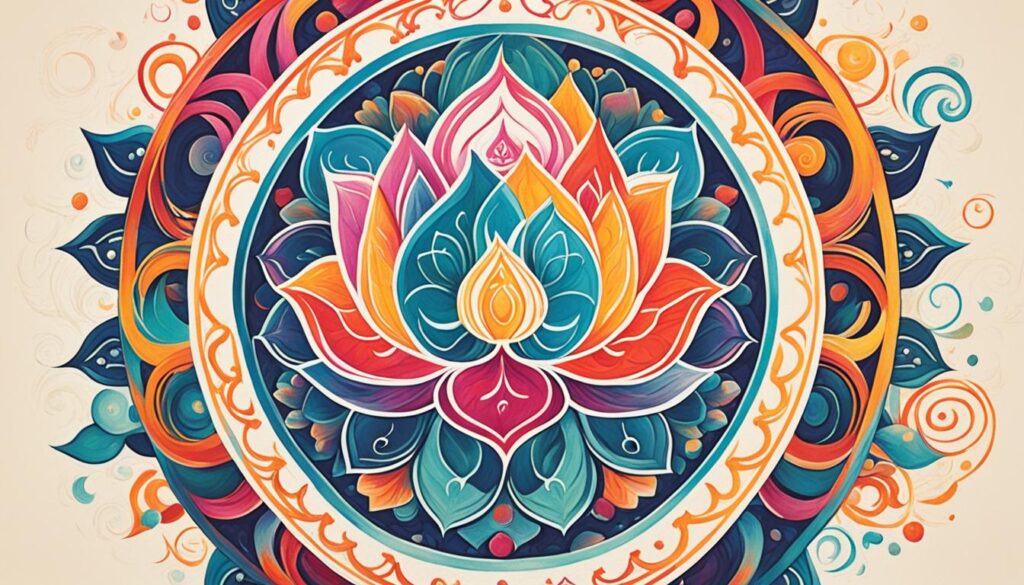
The influence of Buddhism symbols extends beyond traditional art forms. They have also found their way into contemporary design, shaping the aesthetics of various products and spaces. Designers draw inspiration from the elegance and simplicity of these symbols, incorporating them into graphic designs, logos, and even architectural elements.
Buddhism symbols in design not only enhance visual appeal but also imbue products and spaces with a sense of serenity and harmony. Whether it’s a minimalist meditation space adorned with dharma wheel motifs or a fashion accessory featuring the Om symbol, these designs serve as reminders of the spiritual path and promote mindfulness in everyday life.
The following table illustrates some of the prominent Buddhism symbols and their influences on art and design:
| Symbol | Influence on Art | Influence on Design |
|---|---|---|
| Lotus Flower | Represents purity and enlightenment; often depicted in paintings and sculptures. | Inspires floral patterns and motifs in textile and interior designs. |
| Dharma Wheel | Symbolizes the Noble Eightfold Path; used in Buddhist paintings and tapestries. | Influences the design of jewelry, home decor, and furniture pieces. |
| Mandala | Represents cosmic order and spiritual unity; intricately painted or carved on various surfaces. | Inspires geometric patterns in graphic design and architectural elements. |
| Bodhi Tree | Symbolizes the tree under which the Buddha attained enlightenment; depicted in paintings and sculptures. | Inspires organic forms and motifs in product design and interior decor. |
Through art and design, Buddhism symbols continue to captivate and inspire individuals on their spiritual journeys. They serve as powerful reminders of the core teachings of Buddhism, promoting mindfulness, peace, and enlightenment in a visually appealing and accessible way.
Conclusion
The captivating symbols of Buddhism hold deep spiritual significance, providing profound insights into the teachings and philosophy of this enlightening religion. Serving as visual representations of important concepts, these symbols inspire individuals on their spiritual journey towards inner peace and enlightenment.
From the Reclining Buddha, symbolizing transition and ultimate peace, to the Nirvana Buddha, embodying complete enlightenment and liberation from suffering, each symbol carries its own unique meaning and interpretation.
Whether used in meditation and mindfulness practices or integrated into art, architecture, and everyday life, Buddhism symbols continue to have relevance in modern society, reminding us to cultivate mindfulness, compassion, and peace in our daily lives.
By delving into the intricacies of Buddhism symbols, we gain a deeper understanding of the religion’s teachings and traditions, and find guidance on our own spiritual paths. As we embrace the essence of these symbols, we embark on a transformative journey towards serenity and fulfillment.
FAQ
What are some important symbols in Buddhism?
Important symbols in Buddhism include the lotus flower, the dharma wheel, the Buddha statue, and the Bodhi tree.
What do the colors in Buddhism symbolize?
In Buddhism, colors hold specific symbolic meanings. Gold represents enlightenment and spirituality, while blue represents purity and wisdom.
What is the significance of the Reclining Buddha?
The Reclining Buddha symbolizes the Buddha’s journey towards Parinirvana, the final state of peace and enlightenment. It represents the Buddha’s final moments on Earth.
What does the Nirvana Buddha symbolize?
The Nirvana Buddha represents the moment when the Buddha achieved complete enlightenment and liberation from suffering. It radiates a sense of inner peace and harmony.
What role do Buddhism symbols play in meditation and mindfulness?
Buddhism symbols are often used as focal points in meditation and mindfulness practices. They help cultivate inner stillness, concentration, and a deeper connection with the teachings.
What is the meaning of the dharma wheel in Buddhism?
The dharma wheel, also known as the dharmachakra, symbolizes the Noble Eightfold Path and the teachings of the Buddha. It represents the path to liberation from suffering.
How do Buddhism symbols influence art and design?
Buddhism symbols have had a significant influence on the art and design world. They inspire creativity and convey profound spiritual messages in various mediums.
Why are Buddhism symbols culturally significant?
Buddhism symbols have become iconic representations of the religion and its teachings in different cultures. They are integrated into art, architecture, and everyday life.
What is the symbolic meaning of the lotus flower in Buddhism?
The lotus flower represents purity and enlightenment. It symbolizes the journey from the darkness of ignorance to the light of spiritual awakening.
How do Buddhism symbols inspire individuals on their spiritual journey?
Buddhism symbols serve as visual representations of important concepts and teachings. They inspire individuals to cultivate mindfulness, compassion, and inner peace.

